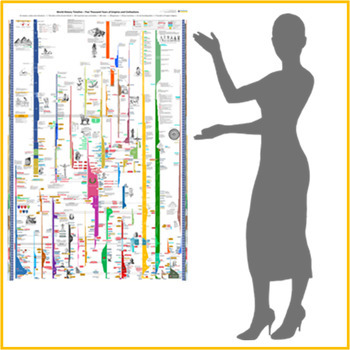World History Timeline – Five Thousand Years of Empires and Civilizations
- Tiff
Description
What is it?
A large and detailed timeline map outlining major civilizations and empires throughout history. It covers a period starting from 3000 BC (Ancient Egypt and Sumer Civilizations) until 2018 .
What is included?
· 45 empires, countries and civilizations
· 7 wonders of the ancient world
· 100 important wars and battles
· 300 rulers – kings, queens, emperors, shah’s, presidents and legendary figures
· 100 geniuses who changed the world (writers, inventors, scientists, philosophers)
· 50 of the most important inventions
· 5 founders of the world’s largest religions
· Color-coding of countries, personas and events make the map very easy to use
Why is it important?
History is usually taught as a collection of individual events – during one lesson students may learn about Ancient Greece, in another about the Crusades or the Mayan civilization. A good student can memorize the material, but it is difficult to put every event in a global and historical context, or to understand its relationship to other developments. Understanding how the events relate to one another, how they stack up in a historical context, and their relative time frames, can be difficult. This is precisely where our timeline comes to rescue. It allows everyone to quickly piece this puzzle together into a clear picture of world history.
How can I use it?
There are a countless number of ways to use this map:
1. Peak a student’s interest in history. The map is colorful and visually stunning. A child can spend hours sifting through all of the details we have incorporated into this product
2. Use the map as a gateway for deeper inquiry into history and the people who shaped it – its multitude of details encourage further learning
3. Use it as a reference tool to place people, events, cultures and empires into historical context
4. Compare the relative power of different empires and how they evolved over time
5. Get a clear sense of the length of existence of various empires and try to understand why some of them lasted for centuries, or even millenia while others quickly faded into oblivion
6. Learn when various events took place in relation to one another – this is a great way of understanding timescale, as well as a very entertaining activity that can easily be transformed into a game:
For example –
What happened first:
The Trojan war or the founding of Beijing?
Genghis Khan’s conquests or the Black Plague?
US Civil War or the creation of the German Empire?
Invention of toilet paper or the cannon?
Which lasted longer?
The Mongol empire or the Ottoman empire?
Merovingian or Carolingian dynasty?
Carthaginian or Seleucid Empire?
Bronze Age or Viking Age?
Who lived earlier?
Moses or Nefertiti?
Remus and Romulus or the Spartan king Leonidas?
Buddha or Caesar?
Gilgamesh or Hammurabi?
Some of the answers can be difficult even for teachers but can be solved with a quick glance at the map. This exercise would radically improve your students’ proficiency and understanding of world history.
How big is it?
Its actual size is 86x130cm (2’10’’ wide by 4’3’’ tall)
However, with a digital file you can print it to any size you like. Just keep in mind that reducing it by 30% of the above size will make the font difficult to read.





